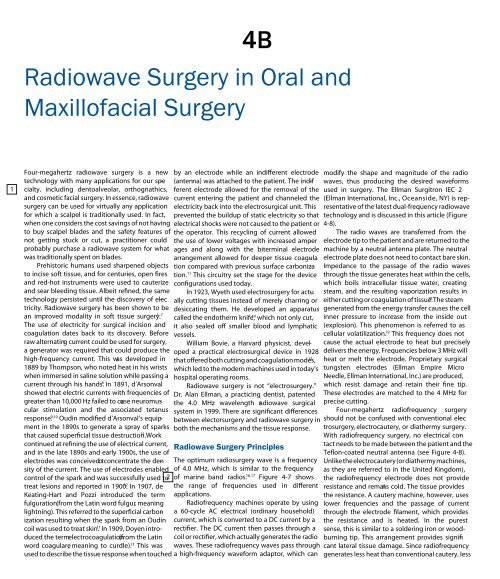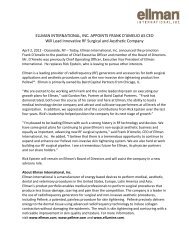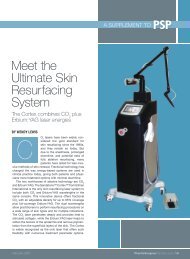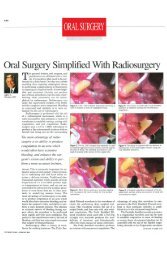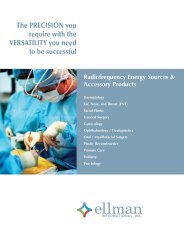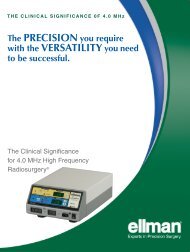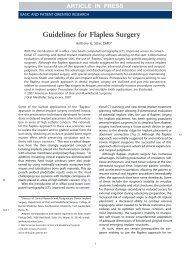Radiowave Surgery in Oral and Maxillofacial Surgery - Ellman ...
Radiowave Surgery in Oral and Maxillofacial Surgery - Ellman ...
Radiowave Surgery in Oral and Maxillofacial Surgery - Ellman ...
You also want an ePaper? Increase the reach of your titles
YUMPU automatically turns print PDFs into web optimized ePapers that Google loves.
1<br />
<strong>Radiowave</strong> <strong>Surgery</strong> <strong>in</strong> <strong>Oral</strong> <strong>and</strong><br />
<strong>Maxillofacial</strong> <strong>Surgery</strong><br />
4B<br />
by an electrode while an <strong>in</strong>dierent electrode<br />
(antenna) was attached to the patient. The <strong>in</strong>dif -<br />
ferent electrode allowed for the removal of the<br />
current enter<strong>in</strong>g the patient <strong>and</strong> channeled the<br />
electricity back <strong>in</strong>to the electrosurgical unit. This<br />
prevented the buildup of static electricity so that<br />
electrical shocks were not caused to the patient or<br />
the operator. This recycl<strong>in</strong>g of current allowed<br />
the use of lower voltages with <strong>in</strong>creased amper -<br />
ages <strong>and</strong> along with the biterm<strong>in</strong>al electrode<br />
arrangement allowed for deeper tissue coagula -<br />
tion compared with previous surface carboniza -<br />
tion. 11 This circuitry set the stage for the device<br />
congurations used today.<br />
In 1923, Wyeth used electrosurgery for actually<br />
cutt<strong>in</strong>g tissues <strong>in</strong>stead of merely charr<strong>in</strong>g or<br />
desiccat<strong>in</strong>g them. He developed an apparatus<br />
called the endotherm knife, 14 which not only cut,<br />
it also sealed o smaller blood <strong>and</strong> lymphatic<br />
vessels.<br />
William Bovie, a Harvard physicist, developed<br />
a practical electrosurgical device <strong>in</strong> 1928<br />
15<br />
that oered both cutt<strong>in</strong>g <strong>and</strong> coagulation modes,<br />
which led to the modern mach<strong>in</strong>es used <strong>in</strong> today’s<br />
hospital operat<strong>in</strong>g rooms.<br />
<strong>Radiowave</strong> surgery is not “electrosurgery.”<br />
Dr. Alan <strong>Ellman</strong>, a practic<strong>in</strong>g dentist, patented<br />
the 4.0 MHz wavelength radiowave surgical<br />
system <strong>in</strong> 1999. There are signicant dierences<br />
between electorsurgery <strong>and</strong> radiowave surgery <strong>in</strong><br />
both the mechanisms <strong>and</strong> the tissue response.<br />
<strong>Radiowave</strong> <strong>Surgery</strong> Pr<strong>in</strong>ciples<br />
The optimum radiosurgery wave is a frequency<br />
of 4.0 MHz, which is similar to the frequency<br />
of mar<strong>in</strong>e b<strong>and</strong> radios. 16,17 modify the shape <strong>and</strong> magnitude of the radio<br />
waves, thus produc<strong>in</strong>g the desired waveforms<br />
used <strong>in</strong> surgery. The <strong>Ellman</strong> Surgitron IEC 2<br />
(<strong>Ellman</strong> International, Inc., Oceanside, NY) is representative<br />
of the latest dual-frequency radiowave<br />
technology <strong>and</strong> is discussed <strong>in</strong> this article (Figure<br />
4-8).<br />
The radio waves are transferred from the<br />
electrode tip to the patient <strong>and</strong> are returned to the<br />
mach<strong>in</strong>e by a neutral antenna plate. The neutral<br />
electrode plate does not need to contact bare sk<strong>in</strong>.<br />
Impedance to the passage of the radio waves<br />
through the tissue generates heat with<strong>in</strong> the cells,<br />
which boils <strong>in</strong>tracellular tissue water, creat<strong>in</strong>g<br />
steam, <strong>and</strong> the result<strong>in</strong>g vaporization results <strong>in</strong><br />
18 either cutt<strong>in</strong>g or coagulation of tissue. The steam<br />
generated from the energy transfer causes the cell<br />
<strong>in</strong>ner pressure to <strong>in</strong>crease from the <strong>in</strong>side out<br />
(explosion). This phenomenon is referred to as<br />
cellular volatilization.<br />
Figure 4-7 shows<br />
the range of frequencies used <strong>in</strong> dierent<br />
applications.<br />
Radiofrequency mach<strong>in</strong>es operate by us<strong>in</strong>g<br />
a 60-cycle AC electrical (ord<strong>in</strong>ary household)<br />
current, which is converted to a DC current by a<br />
rectier. The DC current then passes through a<br />
coil or rectier, which actually generates the radio<br />
waves. These radiofrequency waves pass through<br />
a high-frequency waveform adaptor, which can<br />
19 Four-megahertz radiowave surgery is a new<br />
technology with many applications for our spe -<br />
cialty, <strong>in</strong>clud<strong>in</strong>g dentoalveolar, orthognathics,<br />
<strong>and</strong> cosmetic facial surgery. In essence, radiowave<br />
surgery can be used for virtually any application<br />
for which a scalpel is traditionally used. In fact,<br />
when one considers the cost sav<strong>in</strong>gs of not hav<strong>in</strong>g<br />
to buy scalpel blades <strong>and</strong> the safety features of<br />
not gett<strong>in</strong>g stuck or cut, a practitioner could<br />
probably purchase a radiowave system for what<br />
was traditionally spent on blades.<br />
Prehistoric humans used sharpened objects<br />
to <strong>in</strong>cise soft tissue, <strong>and</strong> for centuries, open res<br />
<strong>and</strong> red-hot <strong>in</strong>struments were used to cauterize<br />
<strong>and</strong> sear bleed<strong>in</strong>g tissue. Albeit rened, the same<br />
technology persisted until the discovery of elec -<br />
tricity. <strong>Radiowave</strong> surgery has been shown to be<br />
an improved modality <strong>in</strong> soft tissue surgery.<br />
This frequency does not<br />
cause the actual electrode to heat but precisely<br />
delivers the energy. Frequencies below 3 MHz will<br />
heat or melt the electrode. Proprietary surgical<br />
tungsten electrodes (<strong>Ellman</strong> Empire Micro<br />
Needle, <strong>Ellman</strong> International, Inc.) are produced,<br />
which resist damage <strong>and</strong> reta<strong>in</strong> their ne tip.<br />
These electrodes are matched to the 4 MHz for<br />
precise cutt<strong>in</strong>g.<br />
Four-megahertz radiofrequency surgery<br />
should not be confused with conventional elec -<br />
trosurgery, electrocautery, or diathermy surgery.<br />
With radiofrequency surgery, no electrical contact<br />
needs to be made between the patient <strong>and</strong> the<br />
Teon-coated neutral antenna (see Figure 4-8).<br />
Unlike the electrocautery (or diathermy mach<strong>in</strong>es,<br />
as they are referred to <strong>in</strong> the United K<strong>in</strong>gdom),<br />
the radiofrequency electrode does not provide<br />
resistance <strong>and</strong> rema<strong>in</strong>s cold. The tissue provides<br />
the resistance. A cautery mach<strong>in</strong>e, however, uses<br />
lower frequencies <strong>and</strong> the passage of current<br />
through the electrode lament, which provides<br />
the resistance <strong>and</strong> is heated. In the purest<br />
sense, this is similar to a solder<strong>in</strong>g iron or woodburn<strong>in</strong>g<br />
tip. This arrangement provides signicant<br />
lateral tissue damage. S<strong>in</strong>ce radiofrequency<br />
generates less heat than conventional cautery, less<br />
1–7<br />
The use of electricity for surgical <strong>in</strong>cision <strong>and</strong><br />
coagulation dates back to its discovery. Before<br />
raw alternat<strong>in</strong>g current could be used for surgery,<br />
a generator was required that could produce the<br />
high-frequency current. This was developed <strong>in</strong><br />
1889 by Thompson, who noted heat <strong>in</strong> his wrists<br />
when immersed <strong>in</strong> sal<strong>in</strong>e solution while pass<strong>in</strong>g a<br />
current through his h<strong>and</strong>s. 8 In 1891, d’Arsonval<br />
showed that electric currents with frequencies of<br />
greater than 10,000 Hz failed to cause neuromuscular<br />
stimulation <strong>and</strong> the associated tetanus<br />
response. 9,10 Oud<strong>in</strong> modied d’Arsonval’s equipment<br />
<strong>in</strong> the 1890s to generate a spray of sparks<br />
11 that caused supercial tissue destruction. Work<br />
cont<strong>in</strong>ued at ren<strong>in</strong>g the use of electrical current,<br />
<strong>and</strong> <strong>in</strong> the late 1890s <strong>and</strong> early 1900s, the use of<br />
electrodes was conceived o tconcentrate<br />
the density<br />
of the current. The use of electrodes enabled<br />
control of the spark <strong>and</strong> was successfully used to<br />
treat lesions <strong>and</strong> reported <strong>in</strong> 1900. 12 In 1907, de<br />
Keat<strong>in</strong>g-Hart <strong>and</strong> Pozzi <strong>in</strong>troduced the term<br />
fulguration (from the Lat<strong>in</strong> word fulgur, mean<strong>in</strong>g<br />
lightn<strong>in</strong>g). This referred to the supercial carbonization<br />
result<strong>in</strong>g when the spark from an Oud<strong>in</strong><br />
coil was used to treat sk<strong>in</strong>. 11 In 1909, Doyen <strong>in</strong>troduced<br />
the term electrocoagulation (from the Lat<strong>in</strong><br />
word coagulare, mean<strong>in</strong>g to curdle). 13 2<br />
This was<br />
used to describe the tissue response when touched
3<br />
Figure 4-7 The 4.0 MHz wavelength of radiofrequency is comparable to that of a mar<strong>in</strong>e b<strong>and</strong> radio.<br />
Figure 4-8 The <strong>Ellman</strong> dual-frequency Surgitron IEC II has notable advantages over conventional<br />
electrosurgery <strong>and</strong> is well suited for cosmetic surgery applications.<br />
collateral damage is seen <strong>and</strong> therefore faster<br />
heal<strong>in</strong>g. Bridenst<strong>in</strong>e found biopsies done with<br />
radiofrequency <strong>in</strong>cision to have thermal damage<br />
zones of 75 microns, which is comparable to the<br />
CO 2 laser. 1 Other studies have confirmed m<strong>in</strong>imal<br />
tissue damage <strong>and</strong> comparable biopsy marg<strong>in</strong>s<br />
with scalpel excision. 20–22<br />
The high-frequency radiowaves are modified<br />
by filter<strong>in</strong>g <strong>and</strong> rectification to produce four dist<strong>in</strong>ct<br />
waveforms:<br />
4<br />
1. Cutt<strong>in</strong>g. This waveform consists of 90% cutt<strong>in</strong>g<br />
<strong>and</strong> 10% coagulation. This is a fully filtered<br />
waveform for microsmooth cutt<strong>in</strong>g<br />
with little tissue damage <strong>and</strong> concomitant<br />
coagulation. Histologically, this is the fastest<br />
heal<strong>in</strong>g waveform.<br />
2. Cutt<strong>in</strong>g/coagulation. This waveform consists<br />
of 50% cutt<strong>in</strong>g <strong>and</strong> 50% coagulation. It is<br />
designed for equal amounts of cutt<strong>in</strong>g <strong>and</strong><br />
coagulation <strong>and</strong> is especially useful <strong>in</strong><br />
<strong>Radiowave</strong> <strong>Surgery</strong> <strong>in</strong> <strong>Oral</strong> <strong>and</strong> <strong>Maxillofacial</strong> <strong>Surgery</strong> 5<br />
vascular areas while ma<strong>in</strong>ta<strong>in</strong><strong>in</strong>g m<strong>in</strong>imal<br />
amounts of lateral heat <strong>and</strong> tissue damage.<br />
3. Hemostasis. This waveform consists of 10%<br />
cutt<strong>in</strong>g <strong>and</strong> 90% coagulation <strong>and</strong> is designed<br />
for direct <strong>and</strong> <strong>in</strong>direct hemostasis techniques.<br />
Its use does not create charr<strong>in</strong>g or necrosis.<br />
This waveform can also be used to perform<br />
unipolar <strong>and</strong> bipolar coagulation.<br />
4. Fulguration (spark gap). This waveform is<br />
designed to generate a shower of sparks,<br />
which provides maximum char <strong>and</strong> necrosis.<br />
High lateral heat <strong>and</strong> maximum hemostasis<br />
are produced with the fulgurat<strong>in</strong>g waveform,<br />
which is used for <strong>in</strong>tentional destruction of<br />
diseased tissue.<br />
To use the optimum characteristics of radiowave<br />
surgery, adjacent tissue damage must be limited.<br />
Time of tissue contact, power <strong>in</strong>tensity, waveform,<br />
<strong>and</strong> frequency of application are the variables<br />
that contribute to the lateral thermal tissue<br />
destruction, as illustrated <strong>in</strong> the formula below:<br />
LH = T × I × W × S<br />
___________<br />
F<br />
where LH is lateral that, T is time, I is power<br />
<strong>in</strong>tensity, W is waveform, S is surface area, <strong>and</strong><br />
F is frequency.<br />
The amount of time that the electrode contacts<br />
the tissue is obviously paramount to prevent<br />
excessive lateral tissue damage. The faster the<br />
electrode passage, the less tissue damage is produced.<br />
A rate of 7 mm/s was proposed by Kalwarf<br />
<strong>and</strong> colleagues. 20 A metaphor to this pr<strong>in</strong>ciple<br />
would be us<strong>in</strong>g a clothes iron. If you move the<br />
iron over a shirt <strong>and</strong> keep mov<strong>in</strong>g, you will have<br />
even heat distribution, but if you leave the iron <strong>in</strong><br />
one spot for too long, you will have a scorch <strong>in</strong><br />
that area ow<strong>in</strong>g to excess heat.<br />
The power <strong>in</strong>tensity is also critical for proper<br />
technique. Optimum <strong>in</strong>tensity will allow a smooth<br />
<strong>and</strong> effortless passage of the active electrode<br />
through the tissue. Too low of a power sett<strong>in</strong>g<br />
will cause stick<strong>in</strong>g of the tissue <strong>and</strong> offer resistance<br />
or dragg<strong>in</strong>g. An excessive power sett<strong>in</strong>g will<br />
carbonize the tissue <strong>and</strong> cause spark<strong>in</strong>g.<br />
The frequency sett<strong>in</strong>g also affects the amount<br />
of lateral heat generation, as well as the heal<strong>in</strong>g<br />
results. A lower frequency (traditional electrosurgery)<br />
generates a less efficient cut <strong>and</strong> produces<br />
more heat, additional postoperative discomfort,<br />
<strong>and</strong> <strong>in</strong>creased heal<strong>in</strong>g time. The optimum frequency<br />
for m<strong>in</strong>imum tissue destruction is 4.0<br />
MHz.<br />
The waveform contributes to lateral heat <strong>and</strong><br />
treatment destruction as well. The fully filtered<br />
current produces the least heat, whereas the fulguration<br />
waveform generates the greatest amount<br />
of heat.<br />
F<strong>in</strong>ally, electrode size is another significant<br />
variable <strong>in</strong> the formula of heat generation. A large<br />
5
6<br />
6 Diagnosis <strong>and</strong> Treatment Plann<strong>in</strong>g<br />
electrode tip requires more power <strong>and</strong> therefore<br />
produces more lateral heat when compared with<br />
a th<strong>in</strong>ner electrode.<br />
Passive electrode<br />
The passive electrode is also called an antenna, a<br />
passive antenna, a neutral antenna plate, or an<br />
<strong>in</strong>different electrode. This plate acts like a radio<br />
antenna by attract<strong>in</strong>g the radio waves emitted<br />
from the mach<strong>in</strong>e <strong>and</strong> channels the energy back<br />
<strong>in</strong>to the unit. The passive electrode is coated with<br />
a Teflon material to elim<strong>in</strong>ate the possibility of<br />
burns or shocks (see Figure 4-8). S<strong>in</strong>ce the passive<br />
electrode is not technically a ground<strong>in</strong>g electrode,<br />
it does not need to contact bare sk<strong>in</strong> <strong>and</strong> may be<br />
placed over cloth<strong>in</strong>g. Some practitioners merely<br />
place the passive electrode under the cushion of<br />
the surgical table under the patient’s shoulder.<br />
The closer the passive electrode to the surgical<br />
site, the less power is required; thus, there is less<br />
chance of lateral thermal damage. Plac<strong>in</strong>g the<br />
antenna close to the surgical site will provide<br />
better reception of the surgical antenna, just as<br />
extend<strong>in</strong>g the antenna on a cellular telephone<br />
<strong>in</strong>creases the reception signal. The passive electrode<br />
plate is usually not placed under the head as<br />
there is less surface area, so plac<strong>in</strong>g it under the<br />
shoulder is adequate. The passive electrode is not<br />
necessary when us<strong>in</strong>g the bipolar mode.<br />
Active electrode<br />
The active electrode is the energized tip of<br />
the radiowave system. The microtip is used to<br />
direct the radio waves through the tissue to make<br />
the <strong>in</strong>cision. The radio waves cause the <strong>in</strong>cision,<br />
not the electrode tip. This is one of the ma<strong>in</strong><br />
differences between radiowave surgery <strong>and</strong><br />
“electrosurgery.” The active electrode tip can be<br />
bent to better navigate anatomic surfaces <strong>and</strong><br />
angles. Many different types <strong>and</strong> configurations<br />
of electrode tips are available. Straight electrode<br />
tips are the most frequently used for tissue <strong>in</strong>cision.<br />
Tungsten microneedles, such as the Empire<br />
Micro Needle, have become very popular for<br />
ultraf<strong>in</strong>e <strong>in</strong>cisions, such as blepharoplasty <strong>and</strong><br />
lesion removal. These tips are very f<strong>in</strong>e <strong>and</strong><br />
long-last<strong>in</strong>g.<br />
Loop electrodes are also popular for the excision<br />
of pedunculated lesions, <strong>and</strong> diamondshaped<br />
electrodes are available that enable an<br />
elliptical <strong>in</strong>cision for better closure. The <strong>Ellman</strong><br />
Vari-Tip electrode consists of a f<strong>in</strong>e wire that<br />
passes through a sleeve. The wire can be extended<br />
or retracted to adjust for the depth of the cut. In<br />
addition, the small diameter of the Vari-Tip<br />
requires reduced power sett<strong>in</strong>gs <strong>and</strong> produces<br />
little collateral tissue heat<strong>in</strong>g. I prefer this tip for<br />
rhytidectomy of a f<strong>in</strong>e sk<strong>in</strong> <strong>in</strong>cision. Although the<br />
po<strong>in</strong>ted microelectrodes are well suited for f<strong>in</strong>e<br />
Figure 4-9 The <strong>Ellman</strong> Empire tungsten electrode.<br />
Figure 4-10 Loop electrodes can be bent to<br />
accommodate a hard to reach place.<br />
<strong>in</strong>cision, they are conical <strong>in</strong> cross section, <strong>and</strong><br />
the deeper they pass through the sk<strong>in</strong>, the wider<br />
the <strong>in</strong>cision, whereas a f<strong>in</strong>e wire has the same<br />
diameter throughout its length.<br />
Ball <strong>and</strong> flat cyl<strong>in</strong>drical electrodes are used<br />
for coagulation of bleed<strong>in</strong>g tissue <strong>and</strong> vessels as<br />
well as ablation of soft tissue lesions, such as nevi<br />
<strong>and</strong> keratoses. Other specialized electrodes are<br />
available for endoscopic brow-lift procedures,<br />
palatopharyngoplasty, tympanoplasty, palatal<br />
graft harvest<strong>in</strong>g, tonsil <strong>and</strong> turb<strong>in</strong>ate shr<strong>in</strong>kage,<br />
depilation, <strong>and</strong> ablation of telangiectasias.<br />
Advantages of radiowave <strong>Surgery</strong><br />
Multiple advantages exist with radiowave surgery<br />
when compared with scalpel <strong>in</strong>cision, electrocautery,<br />
<strong>and</strong> laser soft tissue <strong>in</strong>cision <strong>and</strong> coagulation<br />
(Table 4-1).<br />
The most significant advantages of radiosurgery<br />
are simultaneous cutt<strong>in</strong>g <strong>and</strong> coagulation<br />
without significant lateral tissue damage. This<br />
reduced heat promotes less postsurgical pa<strong>in</strong><br />
<strong>and</strong> faster heal<strong>in</strong>g. 1–7 Another advantage is a<br />
pressureless <strong>in</strong>cision. S<strong>in</strong>ce the radiowave<br />
Table 4-1 Advantages of <strong>Radiowave</strong> <strong>Surgery</strong><br />
Incision without apply<strong>in</strong>g pressure (pressureless<br />
<strong>in</strong>cision)<br />
Simultaneous hemostasis<br />
Bacteria-free <strong>in</strong>cision<br />
Artifact reduction <strong>in</strong> biopsy compared with<br />
electrocautery<br />
The ability to bend or shape the cutt<strong>in</strong>g electrode<br />
for anatomic variation or work<strong>in</strong>g <strong>in</strong> cavities<br />
Produces scarr<strong>in</strong>g equal to or better than scalpel<br />
or laser <strong>in</strong>cisions<br />
Pays for itself <strong>in</strong> not hav<strong>in</strong>g to purchase scalpel<br />
blades<br />
No accidental scalpel <strong>in</strong>juries<br />
No deal<strong>in</strong>g with dull scalpel blades<br />
M<strong>in</strong>imal safety precautions when compared with<br />
lasers<br />
electrode channels the current to the tissue <strong>and</strong><br />
does not cut by heat, it is merely glided through<br />
the tissue. Ow<strong>in</strong>g to the <strong>in</strong>creased control <strong>and</strong><br />
tactile sensitivity, the <strong>in</strong>cision is more precise.<br />
This is especially evident when cutt<strong>in</strong>g very th<strong>in</strong><br />
or mobile tissues, such as eyelid sk<strong>in</strong>, oral mucosa,<br />
or earlobes. Typically, scalpel <strong>in</strong>cision <strong>in</strong> these<br />
areas requires pressure <strong>and</strong> causes dragg<strong>in</strong>g or<br />
bunch<strong>in</strong>g of the tissue.<br />
Biopsy artifact damage is also reduced with<br />
radiowave surgery. Turner <strong>and</strong> colleagues showed<br />
that when compared with CO 2 <strong>and</strong> neodymium:<br />
yttrium-alum<strong>in</strong>um-garnet lasers, there is significantly<br />
less tissue damage, which can affect the<br />
diagnostic ability of the pathologist. 7 They also<br />
reported the pure cutt<strong>in</strong>g waveform of radiowave<br />
surgery to approach the quality of cold knife<br />
excision.<br />
A bacteria-free <strong>in</strong>cision is also possible with<br />
the radiowave electrode. Although the electrode<br />
does not heat, the resistance of the soft tissue<br />
causes a release of energy <strong>and</strong> produces steam<br />
with<strong>in</strong> the cells, which causes vaporization <strong>and</strong><br />
sterilization. In addition, the electrode may be<br />
“steam cleaned” by hold<strong>in</strong>g the electrode between<br />
the layers of moistened gauze <strong>and</strong> activat<strong>in</strong>g the<br />
unit. This causes the electrode to spark <strong>and</strong> produce<br />
steam, which is self-cleans<strong>in</strong>g. This also<br />
allows the electrode to be easily cleaned of debris.<br />
Unlike the electrocautery tip, which is cleaned<br />
with abrasives, the surgical debris may be easily<br />
removed by pass<strong>in</strong>g the electrode tip through wet<br />
gauze <strong>and</strong> activat<strong>in</strong>g the current.<br />
Cl<strong>in</strong>ical Applications <strong>in</strong> Cosmetic<br />
Facial <strong>Surgery</strong><br />
Four-megahertz radiowave surgery is a technological<br />
advance over traditional electrosurgery.<br />
<strong>Radiowave</strong> surgical technique can be applied to<br />
virtually any <strong>in</strong>cisional situation <strong>in</strong> which one<br />
would traditionally use a scalpel, scissors, <strong>and</strong>, <strong>in</strong><br />
many cases, laser.
7<br />
radiowave Blepharoplasty<br />
One of the most useful <strong>in</strong>dications of radiowave<br />
surgery is cosmetic blepharoplasty. This modality<br />
produces scars consistent with scalpel <strong>in</strong>cision<br />
but produces significantly more hemostasis.<br />
In addition, the ability to cut the th<strong>in</strong> tissues of<br />
the eyelid without pressure or tissue drag is<br />
impressive.<br />
The CO 2 laser is an excellent tool for cosmetic<br />
blepharoplasty but is not accessible to many practitioners.<br />
In addition, the <strong>Ellman</strong> radiowave<br />
surgery unit is portable <strong>and</strong> does not require<br />
the doctor, patient, <strong>and</strong> staff safety precautions<br />
that the laser does. Welchs showed histologically<br />
that the 4.0 MHz radiowave surgery causes less<br />
thermal damage on resected periorbital fat pads<br />
when compared with the CO 2 laser. 7<br />
The surgical technique for blepharoplasty<br />
<strong>in</strong>volves the usual mark<strong>in</strong>gs <strong>and</strong> local anesthetic<br />
<strong>in</strong>jections. The sk<strong>in</strong> <strong>in</strong>cision is performed with<br />
the Empire Micro Needle with a pure cutt<strong>in</strong>g<br />
waveform (90% cutt<strong>in</strong>g, 10% coagulation). Sk<strong>in</strong><br />
<strong>and</strong> muscle bleeders are controlled by grasp<strong>in</strong>g<br />
the area with small forceps <strong>and</strong> touch<strong>in</strong>g the<br />
radiowave tip to the <strong>in</strong>strument. After sk<strong>in</strong> excision,<br />
the pure coagulation sett<strong>in</strong>g is used <strong>and</strong><br />
a strip of orbicularis muscle is excised <strong>and</strong><br />
Figure 4-11 The images on the left show the CO 2 laser <strong>and</strong> the bloodless sk<strong>in</strong> <strong>in</strong>cision <strong>and</strong> excision. The<br />
images on the right show the same bloodless surgery us<strong>in</strong>g an <strong>Ellman</strong> Empire Micro Needle with a pure<br />
cutt<strong>in</strong>g mode.<br />
<strong>Radiowave</strong> <strong>Surgery</strong> <strong>in</strong> <strong>Oral</strong> <strong>and</strong> <strong>Maxillofacial</strong> <strong>Surgery</strong> 7<br />
Figure 4-12 The equally bloodless surgical field when remov<strong>in</strong>g muscle <strong>and</strong> fat from the upper eyelids.<br />
coagulated <strong>in</strong> the same manner. The orbital<br />
septum is opened, <strong>and</strong> the fat pads are identified<br />
<strong>and</strong> gently elevated with forceps <strong>and</strong> their base<br />
cauterized with the Empire Micro Needle.<br />
No clamp<strong>in</strong>g is necessary as the cutt<strong>in</strong>g <strong>and</strong><br />
coagulation with the radiowave electrode are<br />
excellent. I have performed over 100 radiowave<br />
blepharoplasties with excellent hemostasis.<br />
I have performed side-by-side comparisons<br />
with 4.0 MHz radiowave surgery with the CO 2<br />
laser for upper blepharoplasty. Figure 4-13 shows<br />
Figure 4-13 A 12-month postoperative scar when<br />
the right lid was <strong>in</strong>cised with the CO 2 laser <strong>and</strong> the<br />
left lid with the <strong>Ellman</strong> <strong>Radiowave</strong> Micro Needle.<br />
8
9<br />
8 Diagnosis <strong>and</strong> Treatment Plann<strong>in</strong>g<br />
blepharoplasty <strong>and</strong> laser <strong>in</strong>cisions on the same<br />
patient. The Empire Micro Needle was used with<br />
a pure cutt<strong>in</strong>g or a cutt<strong>in</strong>g/coagulation (partially<br />
rectified) sett<strong>in</strong>g on the left eyelid <strong>and</strong> the Coherent<br />
Ultrapulse Encore CO 2 laser was used with an<br />
8-watt cont<strong>in</strong>uous-wave sett<strong>in</strong>g on the right<br />
eyelid. As shown <strong>in</strong> the images, both modalities<br />
provided a virtually bloodless surgical field. In<br />
addition, the radiowave surgery side showed a<br />
more esthetic scar <strong>in</strong> the early postoperative<br />
period. At the 3-month comparison, the blepharoplasty<br />
scars were judged equal by tra<strong>in</strong>ed<br />
observers <strong>and</strong> the patients.<br />
For lower blepharoplasty, I prefer the transconjunctival<br />
approach. The conjunctiva <strong>and</strong><br />
capsulopalpebral fascia are <strong>in</strong>cised with the<br />
Empire Micro Needle <strong>and</strong> the fat pads are identified<br />
<strong>and</strong> sectioned as previously mentioned us<strong>in</strong>g<br />
the Empire needle (Figure 4-14), a small ball<br />
electrode, or the <strong>Ellman</strong> #133 electrode.<br />
radiowave rhytidectomy<br />
I have used the microneedle or Vari-Tip electrode<br />
for pre- <strong>and</strong> postauricular rhytidectomy <strong>in</strong>cisions<br />
on a pure cutt<strong>in</strong>g mode <strong>and</strong> have seen the same<br />
heal<strong>in</strong>g results as those with scalpel <strong>in</strong>cision<br />
(Figure 4-15). In addition, the subcutaneous<br />
dissection may be performed with the Empire<br />
Micro Needle <strong>and</strong> hemostasis of the superficial<br />
muscular aponeurotic system (SMAS) <strong>and</strong> muscle<br />
is easily performed with the large ball electrode or<br />
<strong>Ellman</strong> bipolar forceps or simple conduction<br />
through Addison forceps (Figure 4-16). Hav<strong>in</strong>g<br />
the ability to cut <strong>and</strong> coagulate without hav<strong>in</strong>g to<br />
pick up a bipolar or similar <strong>in</strong>strument makes<br />
surgery more simple <strong>and</strong> the field less cluttered. I<br />
also use the large ball electrode to shr<strong>in</strong>k irregular<br />
contours from plication or lumpy areas of the<br />
SMAS. This not only recontours these irregularities,<br />
it also causes shr<strong>in</strong>kage <strong>and</strong> retraction of the<br />
SMAS (Figure 4-17). F<strong>in</strong>ally, greater control <strong>and</strong><br />
dexterity are available when perform<strong>in</strong>g cutbacks<br />
<strong>and</strong> excess sk<strong>in</strong> removal dur<strong>in</strong>g the face-lift.<br />
Lesion removal<br />
One of the true strengths of 4.0 MHz radiowave<br />
surgery is lesion removal. All practitioners have<br />
seen patients present with hypopigmented<br />
depressed scars on their face from liquid nitrogen<br />
ablation of lesions (Figure 4-18). This all too frequent<br />
scenario can be prevented by us<strong>in</strong>g 4.0<br />
MHz radiowave surgery to ablate lesions. The<br />
#133 electrode is a flat cyl<strong>in</strong>der that can be used at<br />
low power with m<strong>in</strong>imal lateral tissue damage. A<br />
Figure 4-14 The conjucntiva <strong>and</strong> lower lid retractors are <strong>in</strong>cised with a cutt<strong>in</strong>g/coagulation current, <strong>and</strong><br />
the fat pads are contoured with a small ball electrode.<br />
Figure 4-15 The <strong>Ellman</strong> Empire Micro Needle is used to make the sk<strong>in</strong> <strong>in</strong>cision <strong>and</strong> to dissect the superficial<br />
muscular aponeurotic system from the sk<strong>in</strong> flap.<br />
Figure 4-16 Coagulation can be performed with the<br />
ball electrode or <strong>in</strong>strument conduction.<br />
small ball electrode can also be used for this. In<br />
the case of suspicious lesions, the loop electrode<br />
may be used at pure cutt<strong>in</strong>g power to perform a<br />
shave biopsy. This low power does not cause<br />
enough artifact to impede histologic analysis. For<br />
most lesions, such as nevi <strong>and</strong> verrucae, the area<br />
is anesthetized with local anesthesia <strong>and</strong> the unit<br />
is set to the cutt<strong>in</strong>g/coagulation sett<strong>in</strong>g. I use surgical<br />
loupes <strong>and</strong> wipe away successive layers of<br />
tissue while wip<strong>in</strong>g the char between passes. The<br />
lesion is treated just to its base or slightly beyond.<br />
It is better to rema<strong>in</strong> conservative <strong>and</strong> tell the<br />
patient that he or she may require a touch-up to<br />
remove a remnant lesion than to overtreat <strong>and</strong><br />
end up with a depression. When treated <strong>in</strong> this<br />
manner, facial lesions leave imperceptible scars,<br />
as shown <strong>in</strong> Figures 4-19 <strong>and</strong> 4-20.
Figure 4-18 Unsightly, depressed, hypopigmented<br />
scars frequently result from aggressive lesion<br />
ablation techniques, such as liquid nitrogen.<br />
<strong>Radiowave</strong> <strong>Surgery</strong> <strong>in</strong> <strong>Oral</strong> <strong>and</strong> <strong>Maxillofacial</strong> <strong>Surgery</strong> 9<br />
Figure 4-17 A preauricular protuberance of the superficial muscular aponeurotic system after plac<strong>in</strong>g<br />
placation sutures. This mound may be shrunk <strong>and</strong> flattened by gentle cauterization with the ball<br />
electrode.<br />
Figure 4-19 Multiple nevi <strong>and</strong> sk<strong>in</strong> tags removed with radiowave surgery.<br />
Figure 4-20 Low-power ablation with the <strong>Ellman</strong> radiowave system <strong>and</strong> #133 electrode produces m<strong>in</strong>imal<br />
lateral tissue damage, thus produc<strong>in</strong>g little scarr<strong>in</strong>g.<br />
Mobile Tissue <strong>in</strong>cision<br />
Incis<strong>in</strong>g fleshy or mobile tissue is always a challenge.<br />
One problem with scalpel <strong>in</strong>cision of fleshy<br />
or mobile tissue is that pressure is required, which<br />
distorts the tissue <strong>and</strong> decreases control <strong>and</strong><br />
precision. The f<strong>in</strong>e-tipped radiowave electrodes,<br />
when used at the proper sett<strong>in</strong>gs, simply glide<br />
through the tissue without pressure. This<br />
pressureless <strong>in</strong>cision technique is excellent for<br />
eyelid tissue, earlobes, <strong>and</strong> oral mucosa (Figure<br />
4-21).<br />
Specialty Applications<br />
A wide variety of specialized electrodes are<br />
available for cosmetic applications.<br />
The <strong>Ellman</strong> Mucotome is an electrode that is<br />
specifically designed for harvest<strong>in</strong>g palatal mucosa<br />
(Figure 4-22). These mucosa grafts are used for
10<br />
10 Diagnosis <strong>and</strong> Treatment Plann<strong>in</strong>g<br />
Figure 4-21 The figure illustrates the ability to make a pressureless <strong>in</strong>cision on mobile tissues<br />
for earlobe repair <strong>and</strong> a lip lesion.<br />
Figure 4-22 Mucotomes are specially designed to<br />
harvest palatal grafts of various widths.<br />
lower eyelid reconstruction <strong>and</strong> various maxillofacial<br />
applications. The Mucotome not only<br />
cuts an exact thickness of mucosa, it also simultaneously<br />
coagulates the very vascular palatal<br />
tissues.<br />
Long contoured electrodes are made for<br />
endoscopic brow <strong>and</strong> forehead lift<strong>in</strong>g, as shown<br />
<strong>in</strong> Figure 4-23.<br />
Aga<strong>in</strong>, any procedure that can be performed<br />
with a scalpel or electrosurgery can be performed<br />
with 4.0 MHz radiowave surgery. I use the Empire<br />
Micro Needle for osteotomy <strong>in</strong>cisions. 24 This<br />
produces less heat <strong>and</strong> promotes faster heal<strong>in</strong>g.<br />
Figure 4-23 Many specialty electrodes are available,<br />
such as this curved, elongated electrode for<br />
endoscopic surgical applications. A curved electrode<br />
used for endoscopic brow surgery is shown.<br />
Hazards, Complications, <strong>and</strong><br />
Caveats<br />
Like any modality, radiowave surgery presents<br />
certa<strong>in</strong> hazards <strong>and</strong> complications (Jon Garito,<br />
<strong>Ellman</strong>n International, Inc., personal communication).<br />
23,24 Excess lateral tissue damage is probably<br />
the most common complication <strong>and</strong> usually<br />
results from operator error (especially novice<br />
cl<strong>in</strong>icians) by fail<strong>in</strong>g to observe the lateral heat<br />
formula discussed previously. Choos<strong>in</strong>g optimal<br />
power sett<strong>in</strong>gs <strong>and</strong> the correct electrode <strong>and</strong><br />
ensur<strong>in</strong>g cont<strong>in</strong>uous movement, with care not to<br />
pass too slowly through the tissue, will prevent<br />
<strong>in</strong>creased tissue damage. Underst<strong>and</strong><strong>in</strong>g the<br />
lateral heat formula is critical to an optimum<br />
cl<strong>in</strong>ical response.<br />
11<br />
Figure 4-24 The <strong>Ellman</strong> 4.0 MHz radiowave system<br />
is well suited for orthognathic <strong>and</strong> reconstructive<br />
procedures.<br />
<strong>Radiowave</strong> surgery should not be used <strong>in</strong> the<br />
presence of flammable anesthetics, liquids, or<br />
sk<strong>in</strong> preparations.<br />
Just as the laser plume can be detrimental,<br />
radiowave surgery causes tissue vaporization <strong>and</strong><br />
potential smoke hazard from particulate <strong>in</strong>halation.<br />
Precautions <strong>in</strong>clude careful <strong>and</strong> controlled<br />
smoke plume evacuation <strong>and</strong> wear<strong>in</strong>g surgical<br />
masks rated for microparticle filtration. Although<br />
not a complication, <strong>in</strong>adequate removal of smoke<br />
will cause an unpleasant smell throughout the<br />
office. If central suction is used, it must be vented<br />
to the outside environment otherwise; you are<br />
merely redistribut<strong>in</strong>g the smoke <strong>and</strong> smell from<br />
one area of the office to another. Special portable<br />
evacuation systems are available with viral <strong>and</strong><br />
activated charcoal filters for both operator <strong>and</strong><br />
patient safety <strong>and</strong> comfort.<br />
<strong>Radiowave</strong> surgery mach<strong>in</strong>es may also <strong>in</strong>terfere<br />
with other electromedical equipment, such<br />
as monitors. In my office, <strong>in</strong>terference with the<br />
electrocardiography monitor was corrected by<br />
plugg<strong>in</strong>g the radiowave mach<strong>in</strong>e <strong>in</strong>to a separate<br />
circuit from the monitor.<br />
Pacemaker <strong>in</strong>terference has been a major<br />
concern <strong>in</strong> the past but is only a problem with<br />
older, nonshielded pacemakers. Most modern<br />
pacemakers are shielded from external radiation<br />
<strong>and</strong> therefore are not a problem. Several surgeons<br />
exist that themselves have implanted pacemakers<br />
<strong>and</strong> rout<strong>in</strong>ely operate with radiowave surgical<br />
units without a problem. 23
The potential exists for <strong>in</strong>terference with<br />
implantable cardioverter-defibrillators (ICDs).<br />
LeVasseur <strong>and</strong> colleagues reviewed this topic<br />
<strong>and</strong> made recommendations, <strong>in</strong>clud<strong>in</strong>g possible<br />
deactivation of the ICD prior to surgery. 24 The<br />
electromagnetic <strong>in</strong>terference of radiowave surgery<br />
may cause the pacemaker to reprogram or<br />
otherwise malfunction. In the case of ICDs, the<br />
<strong>in</strong>terference may cause the device to fire a cardioversion<br />
sequence or reprogram the device. In the<br />
case of an ICD discharge, the surgeon is <strong>in</strong> no<br />
danger of electrical shock because the discharge is<br />
not transmitted, but it may <strong>in</strong>duce dysrhythmias<br />
<strong>in</strong> the patient.<br />
When radiowave equipment is used <strong>in</strong> the<br />
presence of cardiac pacemakers or defibrillators, a<br />
cardiology consultation should be obta<strong>in</strong>ed. It is<br />
possible that the cardiologist may elect to temporarily<br />
<strong>in</strong>activate the device dur<strong>in</strong>g the surgical<br />
procedure. Intraoperative cardiac monitor<strong>in</strong>g<br />
<strong>and</strong> emergency cardiac medications should be on<br />
h<strong>and</strong> <strong>in</strong> the rare case of a cardiac emergency.<br />
Bipolar use of radiowave surgery is safer<br />
when operat<strong>in</strong>g on pacemakers <strong>and</strong> ICDs as current<br />
is concentrated across the tips rather than<br />
through the patient. Short bursts of radiowave<br />
surgical energy (less than 5 seconds) are preferable<br />
to long electrode activation periods. Pauses<br />
between the bursts allow resumption of cardiac<br />
rhythm. 24<br />
Conclusion<br />
Four-megahertz radiowave surgery is a new technology<br />
that provides many benefits <strong>in</strong> cosmetic<br />
surgery. Decreased heat <strong>and</strong> lateral tissue damage,<br />
controlled hemostasis, faster heal<strong>in</strong>g, adaptability<br />
of specialized electrodes, <strong>in</strong>creased tactility,<br />
<strong>in</strong>creased operator <strong>and</strong> patient safety, <strong>and</strong> costeffectiveness<br />
are notable advantages. All of these<br />
advantages are applicable to the very vascular <strong>and</strong><br />
sometimes mobile tissues <strong>in</strong> cosmetic facial surgery.<br />
references<br />
1. Bridenst<strong>in</strong>e JB. Use of ultra-high frequency electrosurgery<br />
(radiosurgery) for cosmetic surgical procedures. Dermatol<br />
Surg 1998;24:397–400.<br />
2. Welch DB, Bryar P. Two year follow up: radiosurgery better<br />
than laser. Ocular <strong>Surgery</strong> News 2002;20(12):<br />
3. Olivar AC, Parouhar FA, Gillies CA, Servanski DR. Transmission<br />
electron microscopy: evaluation of damage <strong>in</strong> human<br />
oviducts caused by different surgical <strong>in</strong>struments. Ann<br />
Cl<strong>in</strong> Lab Sci 1999;29:281–5.<br />
4. Greenbaum SS, Krul EA, Watnick K. Comparison of CO 2 laser<br />
<strong>and</strong> electrosurgery <strong>in</strong> the treatment of rh<strong>in</strong>ophyma. J Am<br />
Acad Dermatol 1988;18363–8.<br />
5. Saidi MH, Alright BD, Setzler FD, et al. Diagnostic <strong>and</strong> therapeutic<br />
conization us<strong>in</strong>g loop radiothermal cautery.<br />
6. Saidi, MH, Setzler FD, Sadler KR, et al. Comparison of office<br />
loop electrosurgical conization <strong>and</strong> cold knife conization.<br />
J Am Assoc Gynecol Laparosc 1994;1:135–9.<br />
7. Turner RJ, Cohen RA, Voet RL, et al. Analysis of tissue marg<strong>in</strong>s<br />
of cone biopsy specimens obta<strong>in</strong>ed with “cold knife,”<br />
CO 2 <strong>and</strong> Nd:YAG lasers <strong>and</strong> a radiofrequency surgical<br />
unit. J Reprod Med 1992;37:607–10.<br />
8. Mitchell JP, Lumb GN. Pr<strong>in</strong>ciples of surgical diathermy <strong>and</strong> its<br />
limitations. Br J Surg 1962;50:314–20.<br />
<strong>Radiowave</strong> <strong>Surgery</strong> <strong>in</strong> <strong>Oral</strong> <strong>and</strong> <strong>Maxillofacial</strong> <strong>Surgery</strong> 11<br />
12<br />
13<br />
14<br />
9. d’Arsonval A. Action physiologique des courants alternatifs.<br />
Soc Biol 1891;43:283–6.<br />
10. d’Arsonval A. Action physiologique des courants alternatifs<br />
a gr<strong>and</strong>e frequence. Arch Physio Norm Pathol 1893;5:<br />
401–8.<br />
11. Pollock SV, Carruthers A, Grek<strong>in</strong> RC. The history of<br />
electrosurgery. Dermatol Surg 2000;26:903–8.<br />
12. Riviere AJ. Action des cournats de haute frequence et des<br />
effleuves du resonateur Oud<strong>in</strong> sur certa<strong>in</strong>s tumeurs<br />
malignes. J Med Interne 1900;4:776–7.<br />
13. Doyen D. Sur las destruction des tumeurs cancereuses accessibles<br />
par la methode de la voltaisation bipolarize et de<br />
l’ectro-coagulation thermique. Arch Elec Med 1909;17:<br />
1791–5.<br />
14. Wyeth GA. Endotherm, surgical adjunct <strong>in</strong> accessible malignancy<br />
<strong>and</strong> precancerous conditions. Surg Gynecol Obstet<br />
1928;47:751–2.<br />
15. Bovie WT. New electro-surgical unit with prelim<strong>in</strong>ary note<br />
on new surgical current generator. Surg Gynecol Obstet<br />
1928;47:751–2.<br />
16. Niamtu J. <strong>Oral</strong> <strong>and</strong> <strong>Maxillofacial</strong> Surgical Cl<strong>in</strong>ics of North<br />
America: Cosmetic Facial <strong>Surgery</strong> 2000;12:771–80.<br />
17. Niamtu J. Radiofrequency applications <strong>in</strong> cosmetic facial surgery:<br />
mak<strong>in</strong>g waves. Plastic <strong>Surgery</strong> Products 2001;11(10):<br />
52–8.<br />
18. Brown JS. Radio surgery for m<strong>in</strong>or operations <strong>in</strong> general practice.<br />
Cosmet Dermatol 2000;7:33–6.<br />
19. Sperli AE. The use of radiosurgery <strong>in</strong> plastic surgery <strong>and</strong> dermatology.<br />
Surg Technol Int VII 1998;April:437–42.<br />
20. Kalwarf KL, Kreici FR, Edison AR, Re<strong>in</strong>hardt RA. Lateral<br />
heat production secondary to electrosurgical <strong>in</strong>cisions.<br />
<strong>Oral</strong> Surg <strong>Oral</strong> Med <strong>Oral</strong> Pathol 1983;55:344–8.<br />
21. Burns RL, Carruthers A, Langtry JA, Trotter MJ. Electrosurgical<br />
sk<strong>in</strong> resurfac<strong>in</strong>g: a new bipolar <strong>in</strong>strument. Dermatol<br />
Surg 1999;25:582–6.<br />
22. Sebben JE. The hazards of electrosurgery [editorial]. J Am<br />
Acad Dermatol 1987;16:869–72.<br />
23. LeVasseur JG, Kennard CD, F<strong>in</strong>ley EM, Muse RK. Dermatologic<br />
electrosurgery <strong>in</strong> patients with implantable cardioverter-defibrillators<br />
<strong>and</strong> pacemakers. Dermatol Surg<br />
1998;24:2333–40.<br />
24. El-Gamal HM, Dufresne RG, Saddler K. Electrosurgery,<br />
pacemakers <strong>and</strong> ICD’s: a survey of precautions <strong>and</strong> complications<br />
experienced by cutaneous surgeons. Dermatol<br />
Surg 2001;27:385–90.<br />
15<br />
16<br />
17<br />
18
12 Diagnosis <strong>and</strong> Treatment Plann<strong>in</strong>g<br />
Chapter: <strong>Radiowave</strong> <strong>Surgery</strong> <strong>in</strong> <strong>Oral</strong> <strong>and</strong> <strong>Maxillofacial</strong> <strong>Surgery</strong><br />
1. AU: Need a noun with this.<br />
2. AU: Change as meant?<br />
3. AU: In text, you have 2. Which is correct?<br />
4. AU: Changes okay? Should be consistent.<br />
5. AU: What do you mean?<br />
6. AU: Figs 4-9 <strong>and</strong> 4-10 need to be cited <strong>in</strong> text.<br />
7. AU: This is not ref 7. Pls advise.<br />
8. AU: Figs 11 <strong>and</strong> 12 must be cited <strong>in</strong> text.<br />
9. AU: Manufacturer <strong>and</strong> location?<br />
10. AU: Fig 4-24 not cited.<br />
11. AU: Pls provide year.<br />
12. AU: Pls provide <strong>in</strong>clusive pages.<br />
13. AU: Is the vol miss<strong>in</strong>g, or should it be 18?<br />
14. AU: Complete the ref.<br />
15. AU: Should this be Physiol?<br />
16. AU: Which journal is this?<br />
17. AU: What is the article title? What is the journal name?<br />
18. AU: Is this the vol number? If not, pls provide it.<br />
Chapter 4B: Author Query Form<br />
LIT-71-99


